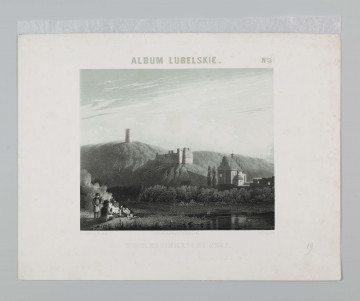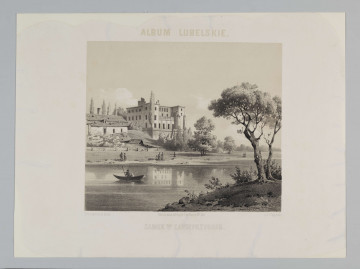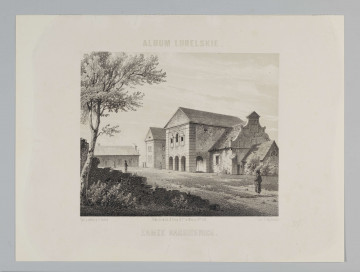
View of Kazimierz from the Vistula
1857
National Museum in Lublin
Part of the collection: Lubliniana. Painting views of Lublin and the Lublin Region
The lithograph shows Lublin from the south and the Zamość Route, originally called the Piasecki Route (today Kardynała Stefan Wyszyńskiego and Zamojska Streets). It was marked out in 1815 on the road “to Piaski” and was created as part of the reconstruction of the town after the Napoleonic wars. It faced the Jesuit church and replaced the old exit from the town towards Zamość from Bernardyńska Street. Part of the road was built on an embankment created from debris from the demolition of the Jesuit college. The route became one of the three main roads leading to Lublin, next to the Warsaw route (today's Aleje Racławickie) and the route to Lubartów, Terespol and Brest (today's Lubartowska Street).
The view depicts private buildings in the nearer plan, with a garden and missionary complex behind them. The buildings of the city are visible in the background. Slightly to the right of the axis - the cathedral church and the Trinity Gate tower, then the Dominican church and the hill with the silhouette of the castle, behind it - the Franciscan church. To the left of the cathedral there is the tower of the Krakowska Gate and the buildings of several churches, including the Reformed and the Bernardine churches.
The creators of the panorama are the draughtsman Adam Lerue (1825-1863), author of the famous Lubelskie Album, and Józef Cezariusz Nowaczyński (1820-1866), one of Lublin's leading printers. A lithographer, engraver and printer, student of Henryk Hirszel, Nowaczyński arrived in Lublin from Warsaw in 1847 and began working in the lithography department of the Lublin Governorate, which he later managed from 1855 to 1868. From 1864, he ran his own printing establishment known as the Artistic-Lithographic Studio and Printing House of Józef Nowaczyński in Krakowskie Przedmieście Street (former Capuchins building) and 2 Gubernatorska Street. Nowaczyński's printing house issued official prints for the districts of Lublin and Radzyń, as well as a wall calendar (photographic calendar) for the year 1871. Nowaczyński also ran printing plants in Krasnystaw (for fifteen years) and Opatów (until ca. 1861-1862), where he issued government regulations, circulars and papers for offices. During the January Uprising, he was imprisoned in the Lublin castle and barracks for printing patriotic prints. After Nowaczyński's death, in accordance with his will, his seventeen-year-old niece, Waleria, took over the plant. In 1890, she married Jan Pietrzykowski, who became the owner of the company.
Renata Bartnik
Author / creator
Dimensions
cały obiekt: height: 55,6 cm, width: 40,5 cm
Object type
graphics
Technique
colour lithography
Material
cardboard
Creation time / dating
Creation / finding place
Owner
The National Museum in Lublin
Identification number
Location / status

1857
National Museum in Lublin

1857
National Museum in Lublin

1857
National Museum in Lublin
DISCOVER this TOPIC
National Museum in Szczecin
DISCOVER this PATH
Educational path